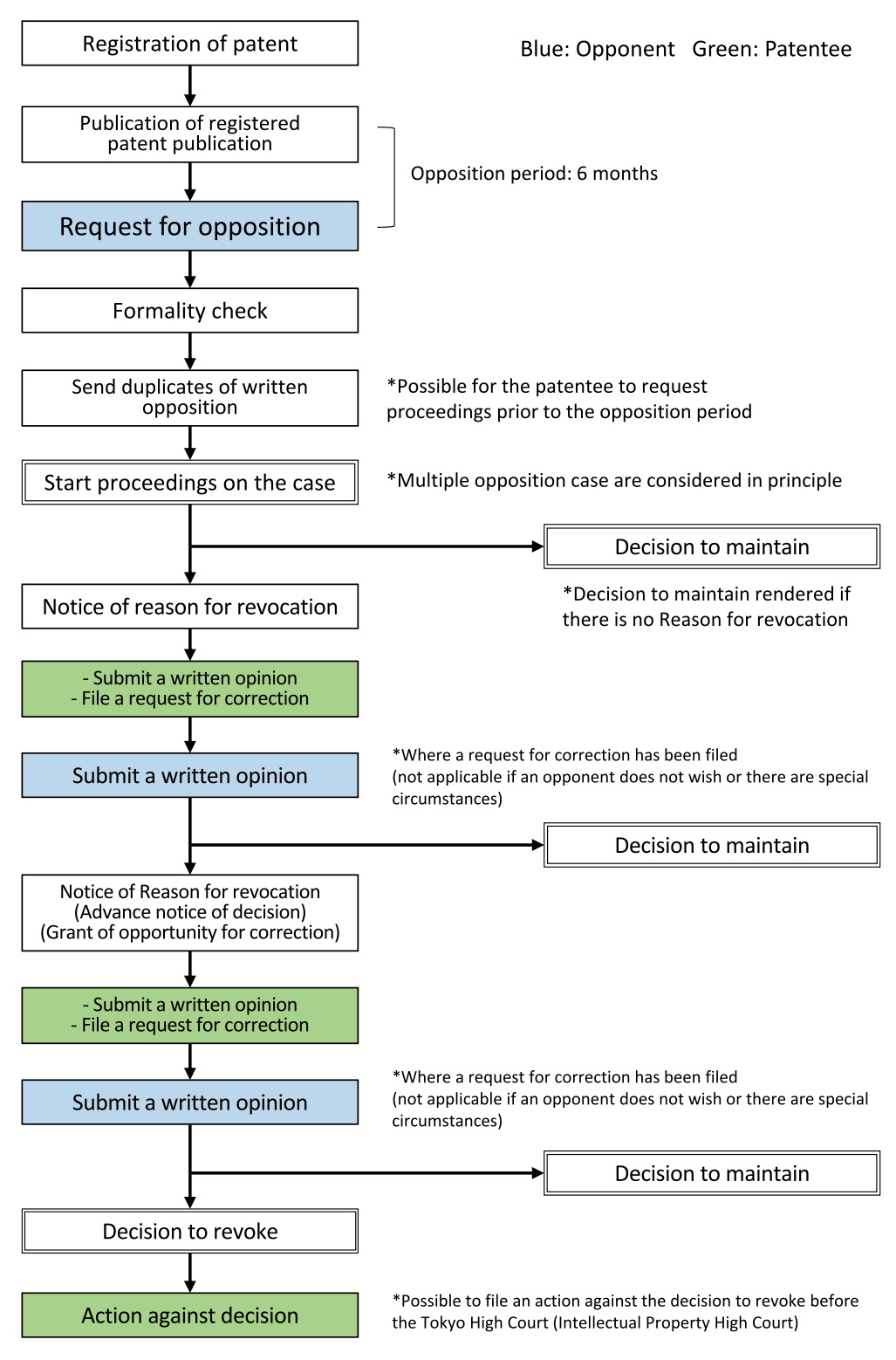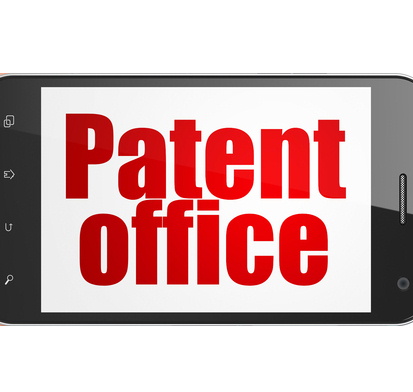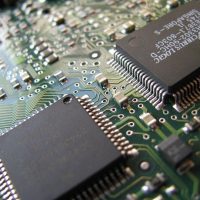Opposition and invalidation trial are procedure for invalidating a patent.
The following table and figure show (1) Comparison table of opposition system and invalidation trial system and (2) Procedure flow chart of the opposition system.
| System of Opposition | System of Invalidation Trial | |
|---|---|---|
| Purport of the System | To realize stable establishment of patent rights at an early stage | To resolve disputes between parties regarding the validity of a patent |
| Procedures | Ex-parte procedures (carried out between the Japan Patent Office and the patentee in principle) | Inter-partes procedures (carried out between a demandant and a demandee or patentee) |
| Eligible Opponent/ Demandant | Any persons | Interested persons only |
| Opposition/ Request Period | Within six months from the publication date of the registered patent publication (not possible after the lapse of the patent right) | Any time after the registration of patent (possible even after the lapse of the patent right) |
| Opposition/ Request and Withdrawal thereof | Possible on a claim-by-claim basis Withdrawal is not possible after notice of reasons for revocation | Possible on a claim-by-claim basis Withdrawal after submission of written reply is possible with consent of the counterparty |
| Reasons for Opposition/ Invalidation | (1) Reasons of public interest (novelty, inventive step, support requirement, enablement requirement, new matter, etc.) | (1) Reasons of public interest (novelty, inventive step, support requirement, enablement requirement, new matter etc.) (2) Reasons related to attribution of rights (usurped application, violation of joint application) (3) Reasons occurring after the grant of patent (violation of enjoyment of rights, violation of treaties) |
| Method of Proceedings | Documentary proceedings (no oral proceedings) | Documentary proceedings & Oral proceedings (documentary proceedings only are also possible) |
| Handling of Multiple Oppositions/Cases | Consolidated proceedings in principle | Proceedings on a case-by-case basis without consolidated proceedings in principle |
| Advance Notice of Decisions/Trial Decisions | Notice of reasons for revocation before decision to revoke is made (advance notice of decision) | Advance notice of trial decision before decision to uphold demandant’s claim (trial decision on invalidation) |
| Decisions/Trial Decisions | Decision to revoke or maintain, or decision to dismiss | Trial decision to approve, reject or dismiss |
| Appeal | An action may be filed by a patentee against a decision to revoke before the Tokyo High Court (Intellectual Property High Court) by appointing the Commissioner of the Japan Patent Office as a defendant. An appeal against a decision to maintain or a decision to dismiss is not possible. | An action may be filed by both a demandant of a trial and a patentee before the Tokyo High Court (Intellectual Property High Court) by appointing the counterparty as a defendant. |
| Fees | 16,500 yen + (the number of claims opposed × 2,400 yen) | 49,500 yen + (the number of claims requested × 5,500 yen) |

Outline of the System of Opposition to Grant of Patent
1. Objective of the Opposition SystemThe System of Opposition to Grant of Patent provides third parties with a wide range of opportunities to seek review of a patent within a fixed period after the grant of the patent so that the Japan Patent Office examines the appropriateness of the disposition of the patent in response to an opposition thereto and, if defects are found in the patent, attains early stabilization of the patent through corrections.
2. Patent Opponents
An opposition to grant of patent may be filed by "any person" without being restricted to interested persons (Patent Act Article 113).
Specifically, a natural person, a juridical person, or an association or foundation which is not a juridical person,but for which a representative or an administrator has been designated may file an opposition (Patent Act Article 6 (1) ii).
However, an opposition to grant of patent cannot be filed anonymously (Patent Act Article 115 (1) i).
If you want to file anonymously, for example, an attorney at IP law firm or an ordinary person can be substitute (so-called dummy).
3. Opposition Period
Any person may file to the Commissioner of the Patent Office an opposition to grant of patent within six months from the publication date of the patent gazette containing the patent (main paragraph of Patent Act Article 113)
4. JPO Fees
16,500 yen + (the number of claims opposed × 2,400 yen)
5. Reason for Opposition
Reasons for opposition to grant of patent are restricted to those specified under the Patent Act Article 113 (e.g., novelty, inventive step, support requirement, enablement requirement, new matter) and the other reasons are not eligible.
6. Procedures
To file an opposition to grant of patent, a prescribed written opposition shall be filed (Patent Act Article 115, Regulations under the Patent Act Article 45-2, Form 61-2). It includes:
(1) Indication of Patent, Opponent, etc.
(2) Reasons for Opposition to Grant of Patent and Indication of Supporting Evidence
7. Proceedings Body and Administrative Judges
An opposition to grant of patent is examined by a panel constituting of administrative judges to sufficiently secure fairness, independence and appropriateness of the proceedings.
8. Scope and Method of Proceedings
The subject of a proceedings is restricted to claims of which an opposition to grant of patent has been filed (Patent Act Article 120-2 (2)).
When multiple requests for opposition to grant of patent have been filed, proceedings thereof are consolidated inprinciple and all the claims opposed by any of the consolidated oppositions are deemed to be the subject of the proceedings.
An opposition to grant of patent is examined based on reasons pleaded by an opponent and evidence.
Reasons that have not been pleaded by an opponent may also be examined ex officio (Patent Act Article 120-2 (1)) andevidence that has not been pleaded by an opponent may also be adopted by a panel.
All opposition cases to grant of patent are examined through documentary proceedings (Patent Act Article 118 (1)).
9. Notification of Reasons for Revocation and Request for Correction
Where a patent examined by a panel has been determined to be revoked, a patentee will be notified of reasons for revocationand given an opportunity to submit a written opinion and make a correction within a designated adequate time limit.
Apatenteemay submit a written opinion within a designated time limit (Patent Act Article 120-5 (1)), and may file a request for correctionof the scope of claims, etc. (Patent Act Article 120-5 (2)).
The second notice of reasons for revocation is the notice ofreasons for revocation (advance notice of decision) in principle.
10. Decision to Revoke and Appeal
When multiple requests for opposition to grant of patent has been filed for multiple claims, a panel will make a decisionof revocation or a decision of maintenance for each of these claims.
Revocation action against an appeal decision may be made by a patentee to the Tokyo High Court (Intellectual PropertyHigh Court) (the Patent Act Article 178(1)).
Revocation action cannot be made against a decision of maintenance (the Patent Act Article 114(5)). Meanwhile, invalidation trials can be filed.











